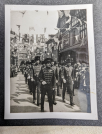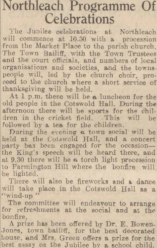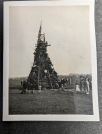This is the third of four projects that undergraduate History students at the University of Gloucestershire are conducting for the Centre in 2023, in partnership with a number of local heritage institutions in the area, including City Voices. In this project, students are researching how Gloucestershire has honoured royal celebration, and how it has mourned royal tragedy. It involves students Amy Brett, Sam Elliott, Elliott Lloyd, Sam Preece, Josh Priestley, and Sam Turton.
We started with a preliminary exploration of royal events that have taken place across the UK, as well as in Gloucestershire. We started as far back as 1327, examining the brutal murder of King Edward II. While we found a large amount of information about the architecture of King Edward’s tomb at Gloucester Cathedral, we quickly realised that we could find little information about the effect the King’s death had on Gloucestershire or how the county responded to it.

We discovered that royal jubilees were not really publicly celebrated before the reign of King George III. The most memorable local celebration took place under King George V, whose silver jubilee took place in 1935. This was an important event because we have found no evidence that King George III or Queen Victoria had local silver jubilee celebrations.



Pictures from the 1935 Silver Jubilee of George V (D4920/2/3/40, Gloucestershire Archives and Heritage Hub), and an article on local celebrations in Western Daily Press – Wednesday 1 May 1935, p. 8, British Newspaper Archive.
From our research at the Gloucestershire Archives and by using the British Newspaper Archive, we discovered that some of the de-facto traditions that took place as part of jubilee celebrations in 1935 and 1977 are still evident today. One example of this tradition is from the 1935 jubilee, when bonfires or beacons were lit across the county, such as those at Northleach, Cleeve Hill and Robinswood Hill. Similarly, a formal military parade took place in Gloucester city centre, starting from Gloucester Cathedral. This tradition still takes place in Gloucestershire, but instead of the regular military it is done by local Cadet Units.
Some of our group members have visited Gloucestershire Cathedral Archive to discuss with their archivist the role the Cathedral has played in royal celebrations and commemorations. The Cathedral has a limited collection on Royal celebrations (especially in comparison with Gloucestershire Archives) because it was only in the 21st century that the Cathedral became a hub for Royal Celebrations. Two notable exceptions to this are a note added to the record of service book of a small memorial service to commemorate the death of King George VI in 1952 (no collection was taken, and there is no note of how many people attended), and the moat of flowers left at the Cathedral following the death of Diana, Princess of Wales in 1997.
We intend to look more closely into local newspaper reports held in the British Newspaper Archive to explore further reports of how Gloucestershire celebrated royal events and mourned royal tragedy. We will be making more visits to Gloucestershire Archives to collect photographic materials, and we’ll also spend a research day at the Gloucester Cathedral Archive to explore their collection further and to gather data on historic and more recent royal events.